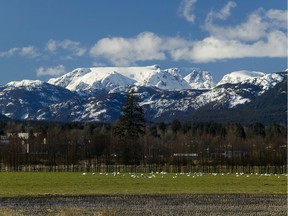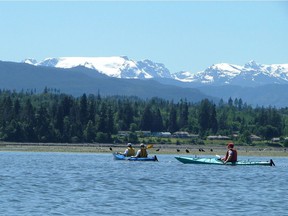The melting of the glaciers is accelerating because the island’s glaciers are small to begin with, and recent events like this summer’s heat dome and sustained temperatures above 30 C have accelerated their disappearance.

Article content
VICTORIA – Vancouver Island’s glaciers are disappearing and fast.
Commercial
This ad has not been uploaded yet, but your article continues below.
Article content
There are about 40 of the ice pockets, on average, about a third of a kilometer in size along the island’s long mountainous spine, but none of them will last much longer, says a glaciologist.
“They are receding before our eyes,” says Brian Menounos, an earth science professor at the University of Northern British Columbia who has extensively studied glaciers off the coast of British Columbia.
Menounos estimates that every ice pack on the island will disappear by mid-century, including the iconic Comox glacier, a symbol of the valley that slowly but surely recedes year after year.
Rocky outcrops have appeared along its length in recent years, with a bare peak emerging from the center of the glacial mass. Exposed rock absorbs heat, accelerates melting, and eventually fragments the ice pack.
Commercial
This ad has not been uploaded yet, but your article continues below.
Article content
“Soon,” Menounos said, “it just won’t be there.”
The melting of the glaciers is accelerating because the island’s glaciers are small to begin with, and recent events like this summer’s heat dome and sustained temperatures above 30 ° C have accelerated their disappearance.
But “human-induced climate change” is the real culprit, Menounos said, as increasing amounts of greenhouse gases in the atmosphere alter weather patterns and temperatures.
He says rising surface temperatures and changes in rainfall – less snow and more rain during critical winter months – don’t allow the Comox Glacier to replenish its ice and store water.
And so it continues to shrink in area and mass.
Retired lumberjack Fred Fern has been taking photos of the Comox Glacier every year since 2013, and the receding mass of ice is easy to see in the pictures.
Commercial
This ad has not been uploaded yet, but your article continues below.
Article content
Using Google Earth, Fern has calculated that the Comox glacier lost 15 vertical feet after this summer’s heat, and up to 120 vertical feet since its first photo in 2013.
“The loss this summer was the worst I’ve ever seen in my life,” said the 64-year-old, who has been living in the Comox Valley since he was 15. “That’s vertical loss of feet: thickness. Not only is it melting at the outer edges, but now it is upside down with the rock exposed. “
He said the Comox glacier “is almost unrecognizable” from years past, adding that the area between Mount Albert Edward and Comox used to have 25 smaller glaciers, but has now shrunk to four or five.
“It’s climate change, without a doubt,” he said.

A study from the University of Northern British Columbia found that between 1985 and 2005, the glacier area on Vancouver Island shrank from 18.2 square kilometers to 14.5 square kilometers, a loss of 20 percent. Losses since then are expected to be much greater.
Commercial
This ad has not been uploaded yet, but your article continues below.
Article content
The average size of the island’s glaciers was about 0.3 square kilometers, much smaller than the provincial average of 2.11 square kilometers.
There are 17,000 glaciers in British Columbia and most are facing disappearance.
Glaciologists estimate that 22 billion cubic meters of water are lost from glaciers in the province each year. That’s enough to fill BC Place Stadium 8,300 times.
Menounos said the link between rising carbon dioxide levels and melting ice is clear, and many of the province’s glaciers are not expected to survive until the end of the century.
A winter can be colder and receive a lot of snow. But the long-term trend points in one direction: continued melting.
Imagine walking down a sand dune. Every step you take forward, you take a step back, ”Menounos said.
Commercial
This ad has not been uploaded yet, but your article continues below.
Article content
In a recent study co-authored by Menounos, researchers found that 21 percent of sea level rise can be traced back to melting glaciers.
The loss of that slow trickle of icy water into mountain streams is predicted to have consequences for British Columbia’s salmon populations and the web of life that relies on the cooling effects of glacier runoff.
“The change in the last 150 years, some of it is so rapid that we haven’t seen it in the last 10,000 years,” said Johannes Koch, a glaciologist at Kwantlen Polytechnic University who spent the last 20 years studying glaciers in Garibaldi Park. and the Pemberton Icefield. “Most ecosystems are good at adapting to things, but they take time.”
People too. By August, about a quarter of the water in mountain rivers comes from melting glaciers in many watersheds in British Columbia, including the Lower Continent and the Okanagan. If we lose them in the summer, Koch said it would be a bad time for farming.
Commercial
This ad has not been uploaded yet, but your article continues below.
Article content
Menounos said that is one of the effects of the glacier’s disappearance: a loss of buffer in late summer versus warmer, drier periods.
In the Comox Valley, the glacier helps fill Lake Comox, the source of drinking water for some 50,000 valley residents.
The basin is 461 square kilometers and reaches up to the top of the Comox glacier and the mountains that surround Lake Comox. Within the basin, there are several sub-basins named after the streams and rivers that flow through them, including Upper Puntledge, Cruikshank, Boston Creek, and Perseverance Creek.
Water that falls to the ground in the form of snow or rain anywhere in the Lake Comox watershed eventually flows into Lake Comox.
BC Hydro controls the reservoir for power generation. Spokesman Stephen Watson said the glacier makes up only a small percentage of the water in the lake, saying that most of the volume comes from rain and melting snow.
Commercial
This ad has not been uploaded yet, but your article continues below.
Article content
However, he noted that four consecutive years of drought have had a dramatic effect on the glacier, and the utility continues to model its hydroelectric dam operations in the area with detailed forecasts.
As for Fern, he worries that “overbuilding” in the Comox Valley will eventually put more pressure on water supplies as climate change continues to slide.
He said people need to be aware of ailing river systems like the Columbia and Colorado that are being depleted by overdevelopment in the western United States, and said water and climate change should be key considerations when expanding rivers. communities.
“There is going to be a shortage of water … we don’t need a disappearing glacier to see climate change,” Fern said. “Lytton was burned to the ground this summer, 500 people died in heat waves … anyone debating this … I just don’t know.”
Commercial
This ad has not been uploaded yet, but your article continues below.
Article content
On the mainland, Doug Washer has been leading people in the mountains for three decades. Since 2013, that means taking tourists to explore the electric blue ice cave of the Pemberton Icefield.
“What we do in those ice caves is take nice pictures. But from a guide’s perspective, we are seeing changes over the years, ”he says. “There’s nothing like monitoring climate change like sitting there and watching an ice cube melt.”
Washer says his team has documented an average of 26 feet of vertical ice loss each summer. That pushed them to move to higher elevations.
“We just can’t travel there with guests. The cracks are too big, sinks have opened. It’s too dangerous, ”Washer explains. “It changed a lot, so fast.”
Mike Douglas recalls first skiing the Horstman Glacier on Blackcomb Mountain in 1988, when it seemed “something that would always be there.”
As a professional skier, Douglas says he cut his teeth on the glacier during the first half of the 1990s. At that time, he would see up to 2,000 people and 20 summer ski camps a day on the glacier.
Fast forward 33 years, that glacier has almost gone to the point where they had to remove the T-bar last year. It’s like a bowl of milk, ”he says. “That is something that happened before my eyes.”
Reference-vancouversun.com